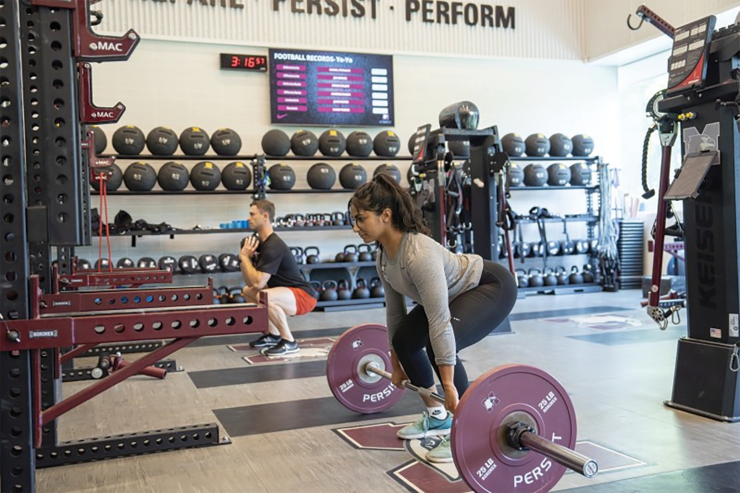STRENGHT: All forms of resistance training programs are beneficial – regardless of how much you lift, how often, and how many times, researchers have found…
By WSAM Correspondent
Whether you use heavy or light weights, lifting them as many times as you can builds strength and muscle. The details of how you go about it are less important than simply making a habit of it, researchers have determined.
After studying the most popular variables among resistance training programs – how much you lift, how often, and how many times – kinesiologists at McMaster University have found all forms of resistance training are beneficial, including body-weight exercises such as planks, lunges and push-ups.
“There are a dizzying number of factors and combinations to consider when creating a weightlifting program to maximize strength and muscle growth,” says Stuart Phillips, a Kinesiology professor who conducted the work with graduate students Bradley Currier and Jonathan Mcleod.
“This is an age-old debate among athletes and strength and conditioning coaches: what combination leads to the best gains?” For the study, published on Monday in the British Journal of Sports Medicine, researchers reviewed 192 randomised, controlled studies with a total sample size of more than 5 000 people evenly split between women and men, making it the single largest project of its kind.
The work is the culmination of years of planning, collecting and analysing massive amounts of data revolving around three key resistance-training variables: higher versus lower loads, single versus multiple sets, and training frequency: whether one, two or three (or more) sessions per week.
Most fitness experts have come to believe that using the heaviest weights – which can only be lifted three to five times – works best for building strength while using weights that can be lifted eight to 10 times works best for building muscle size.
Based on their original research, McMaster researchers have spent the last decade or more pushing back against the idea that heavier weights are the only option. Phillips and his team have published several papers showing significant gains are possible when lifting lighter weights toward the point of exhaustion. That can mean 20 to 30 repetitions, sometimes more. In this comprehensive review of research from across their field, the researchers found that to maximize muscle strength, lifting heavier weights is most effective, while to maximise muscle size, one should do each exercise several times and the weight lifted is less important.
“Our analysis shows that every resistance training prescription resulted in strength and muscle mass gains. Complex prescriptions are sufficient but unnecessary to gain strength and muscle. Simple programs are extremely effective, and the most important result is that people can benefit from any weightlifting program,” says Currier. “Seek guidance if you are unsure where to begin and how to progress, but it doesn’t need to be complicated.”
Researchers say the analysis is good news for anyone, regardless of age, interested in gaining strength and maintaining more muscle, which are important to preventing injury, maximising mobility and optimising metabolism.
“The biggest variable to master is compliance,” said Mcleod, “Once you’ve got that down, then you can worry about all of the other subtle nuances, but our analysis clearly shows that many ostensibly important variables just aren’t that essential for the vast majority of people.”
TRAINING WHEN SICK
IMPLICATIONS: While there is no definitive answer, potential health consequences of stubbornly pushing exercise through illness might be dire….
By Nonhlanhla Makhajane
When you’re in the midst of a productive gym routine or training plan, falling sick can be incredibly frustrating. It hinders your progress and puts a halt to the momentum you’ve been building. While we’ve all heard that training when sick is not recommended, many of us still struggle to follow this advice.
In an article in the latest edition of Fitness, it cautions that while there isn’t a definitive black-and-white answer, various sources, including health and sport websites, refer to the “neck check” rule.
Thing is during winter, it becomes more likely for us to catch unwanted illnesses. It’s understandable that individuals might want to ignore their sickness, especially when they’ve invested significant time and money into training for an important event.
For instance, physique athletes preparing for a competition can experience a major setback in their conditioning progress by missing just 10 days of training. However, it’s crucial to recognise that the setbacks caused by training, preparation, or performance interruptions are far less severe than the potential health consequences of stubbornly pushing through illness.
Training when you are sick has negative implications for your health, and exercising when your body is already under strain can have long-term effects.
The article goes further to say training hard weakens the immune system, which is responsible for combating infections. Intense exercise increases the production of cortisol and other stress hormones that decrease the activity of your natural ‘killer cells’—T cells—which fight the microorganisms causing infections. Blood lymphocyte levels drop, reducing your resistance to infections.
If you’re getting sick, your body may be fighting an infection while also dealing with the stress hormones and waste products produced during exercise. Therefore, if you’re already sick, the inevitable outcome is evident.
So, when should you train or compete, and when should you put the brakes on? While there isn’t a definitive black-and-white answer, various sources, including health and sport websites, refer to the “neck check” rule. If your symptoms are above the neck, you can proceed with caution. Mild head colds, sore throats, and sneezing may not hinder your training significantly.
However, if your symptoms are below the neck, it’s time to pause and allow your body to recover. Chest infections, coughs, and body aches indicate that training should be temporarily halted. Certain strains of the flu virus can lead to myocarditis, inflammation of the heart wall, and are responsible for sudden cardiac death in 5-22% of athletes under 35 years of age.”
Although it’s not guaranteed that a viral infection accompanied by training will inevitably lead to the aforementioned outcomes, it is reason enough to exercise caution rather than risking disaster.
So, what should you do if you’re sick and concerned about losing valuable training time? Here are some suggestions:
*Prioritise your health
If you haven’t been screened for underlying heart conditions, it’s crucial to undergo a stress test and an exercise electrocardiogram (ECG) under supervised conditions. Identifying any latent heart conditions will significantly impact your decision-making regarding training, supplement usage, and whether you should exercise while sick.
*Monitor your heart rate
Train with a heart-rate monitor and become familiar with your resting heart rate during each phase of your training. As you approach your taper, pay attention to your heart rate upon waking each morning. An elevated resting heart rate (7-10 beats per minute higher than your normal) can indicate the presence of an infection.
*Consider exercise volume, intensity, and progression
Implement a well-researched and periodized training program that allows for gradual increases in training load and intensity. Take into account factors such as exercise and training history, allergies, weather conditions during pre-season and in-season training, susceptibility to injury, and stress levels. Keeping a training logbook will help you track training volume, fatigue levels, food intake, and overall well-being.
Always remember that training while sick is not advisable, even if it’s just a mild cold. Monitor your heart rate, assess fatigue levels, and observe how your body reacts to exercise. Listen to your body and prioritise safety over taking unnecessary risks.
Ultimately, resting and allowing your body to recover when sick is crucial for your overall health and long-term performance. While it may be disappointing to put your training on hold temporarily, it’s a necessary step to prevent further setbacks and potential health complications.
By understanding the importance of rest, following the recommended guidelines, and making informed decisions, you can strike a balance between achieving your fitness goals and safeguarding your health and well-being.































